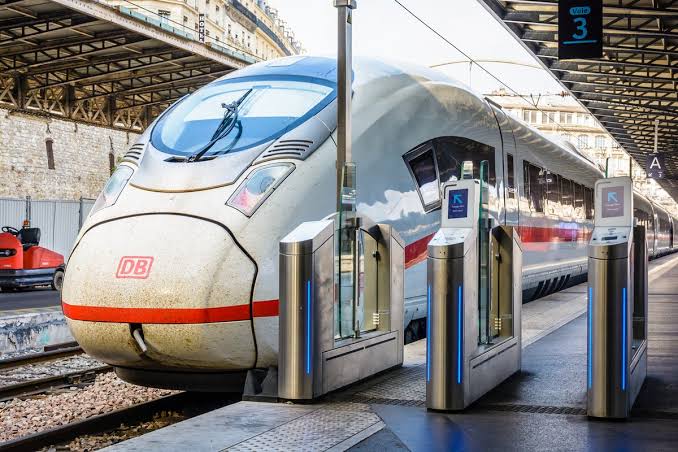As of December 2024, travellers experienced a game-changing high-speed rail service connecting Berlin and Paris directly. Operated by France’s renowned TGV service, this route reduced travel time to approximately seven hours, offering a swift Berlin to Paris train alternative that rivalled short-haul flights in both convenience and environmental responsibility.
For decades, travellers between these iconic European capitals faced either lengthy journeys with multiple transfers or reliance on short flights. With the new Berlin–Paris High-Speed Train, commuting became simpler, faster, and greener. Passengers benefit from spacious seating, onboard dining, and Wi-Fi, making the journey not just a means of transportation but an opportunity to work, relax, or connect during the trip.
Beyond comfort, this new service addresses growing concerns about carbon emissions. Compared to air travel, the train produced considerably less environmental impact, aligning with EU climate targets for 2030. By cutting reliance on airports, travellers saved time previously lost to check-in lines and security screenings, creating a seamless Berlin to Paris train experience that balances efficiency and leisure.
Table of Contents
Why the Berlin–Paris High-Speed Train Was a Milestone for European Travel
The introduction of this service marks a key milestone in Europe’s transportation network. Demand for sustainable, direct travel between major urban hubs has been steadily growing. Environmental advocates, business travellers, and tourists alike welcomed the new route as it promoted a swift Berlin to Paris train connection, enabling better connectivity without compromising the environment.
The direct service also allows travellers to skip transfers that had historically made rail travel cumbersome. Previous routes often required changes in cities such as Cologne or Frankfurt, adding hours to already long journeys. With this new route, both Berlin and Paris stations, centrally located, offered easy access to city attractions, public transit, and urban conveniences, making the overall experience effortless.
Travel Experience on the Berlin–Paris High-Speed Train
Passengers reported a level of comfort and convenience rarely found in European train travel. Modern trains featured spacious seating, allowing for work or relaxation, and the onboard dining experience included snacks and meals catering to international tastes. Connectivity was another highlight, as high-speed Wi-Fi made it possible for business travellers to stay productive, while tourists could plan their visits in real time.
The journey itself, lasting about seven hours, combines speed with a sense of serenity. Travellers could enjoy scenic views of Germany’s lush landscapes and France’s charming countryside, a luxury unavailable on flights. This made the Berlin–Paris High-Speed Train not just a transport service, but a memorable part of the travel experience.

What the Berlin–Paris High-Speed Train Means for Eco-Conscious Travelers
Environmental responsibility plays a key role in the train’s launch. Compared with planes, trains generate a fraction of the carbon footprint for the same route. EU targets for 2030 aimed to reduce greenhouse gas emissions significantly, and expanding high-speed rail infrastructure between major cities was a core strategy.
By offering a seamless Berlin to Paris train route, the initiative encourages travellers to shift away from aviation for shorter distances. This change aligned personal convenience with environmental impact, giving travellers a practical way to contribute to climate goals without sacrificing speed or comfort.
Ticketing, Accessibility, and Frequency: Making High-Speed Travel Work
The Berlin–Paris High-Speed Train offered multiple daily departures, ensuring flexibility for tourists, locals, and business travellers alike. Ticket prices started from around €59, with early booking discounts available; making this swift Berlin to Paris train option both affordable and competitive with flights.
Accessibility was another strong point. Both departure and arrival stations were centrally located, with public transport connections and city-centre proximity making travel to and from stations quick and stress-free. Travellers who previously faced complicated airport transfers now find a smoother, more predictable experience.
European Rail Expansion: The Big Picture
This route is part of a wider effort to expand Europe’s high-speed rail networks. In recent years, campaigns have promoted train travel over short-haul flights, highlighting the combined benefits of sustainability, comfort, and efficiency. Other notable high-speed services, such as London-Paris via Eurostar, demonstrated that cross-border rail travel could compete effectively with flights.
The Berlin–Paris High-Speed Train followed the same principle, offering speed, affordability, and convenience without compromising environmental responsibility. It also illustrated how rail infrastructure could transform urban connectivity and strengthen economic and cultural ties across countries.
Read Also: GEA Expands into Turkey with EgitimAL Merger to Enhance Global Education Access
How Travellers Responded to the Berlin–Paris High-Speed Train
Feedback from passengers on the Berlin–Paris High-Speed Train has been overwhelmingly positive, reflecting a travel experience that blends speed, comfort, and convenience in an unprecedented way. One of the standout features frequently highlighted is the journey time — approximately seven hours between Berlin and Paris. While this might seem lengthy compared to a flight, passengers report that the journey feels considerably shorter thanks to the train’s thoughtfully designed amenities and the smooth, almost hypnotic rhythm of the high-speed tracks. Modern seating, spacious legroom, reliable Wi-Fi, power outlets at every seat, and quiet carriages make it easy for travellers to work, read, or relax in comfort, turning travel time into productive or restful hours. Business travellers, in particular, have embraced the route for the ability to conduct meetings, prepare presentations, or catch up on correspondence, effectively transforming transit time into valuable work time.
Reliability is another factor passengers repeatedly praise. High-speed rail schedules are well-coordinated, with minimal delays and convenient departure and arrival times in city-centre stations. For travellers accustomed to the unpredictability of flights, the Berlin–Paris High-Speed Train provides a dependable and stress-free alternative. The consistent on-time performance not only reassures commuters but also fosters confidence in long-term use, encouraging repeat journeys among both business professionals and leisure travellers alike.
Tourists, meanwhile, have found new opportunities to explore Europe in a more relaxed and scenic way. Unlike air travel, which often limits passengers to airports and adds waiting time for security and boarding, the train journey offers a chance to experience the European landscape firsthand. Rolling countryside, charming villages, and picturesque towns unfold along the route, creating a unique, immersive travel experience. Many tourists now integrate the high-speed train into multi-city itineraries, hopping easily between Berlin, Paris, and other destinations along the route without the stress of flights or complicated transfers. For those looking to enjoy a slow travel experience, this method balances efficiency with the joy of observation, allowing them to witness the gradual transition of landscapes and cultures along the way.
For locals, the service has become a practical commuting option, supporting cross-border work, educational travel, and weekend getaways. Families, students, and professionals alike have embraced the convenience of connecting two major European hubs without relying on flights or long car journeys. The train also encourages environmentally conscious choices, offering a sustainable alternative to short-haul flights and contributing to Europe’s broader commitment to reducing carbon emissions.
Beyond individual convenience, the Berlin–Paris High-Speed Train has transformed perceptions of European travel. It demonstrates how efficiency, comfort, and sustainability can coexist, providing a model for future high-speed rail projects across the continent. Passenger feedback consistently highlights the combination of speed, reliability, and comfort as a defining feature, making the train not just a means of transport, but a preferred travel experience. As more travellers discover the benefits of this service, the Berlin–Paris route is poised to redefine cross-border mobility in Europe for years to come.

A Greener, Faster, and Smarter Way to Travel
The Berlin–Paris High-Speed Train has revolutionised European travel by seamlessly combining efficiency, eco-consciousness, and passenger comfort. Offering a direct and smooth Berlin to Paris train experience, it has significantly reduced travel stress, connected two of Europe’s most iconic cities, and promoted sustainable mobility in an increasingly climate-conscious world.
Passengers now enjoy the freedom to work, unwind, or simply take in the scenic landscapes passing by, making the journey as enjoyable as the destination. For business travellers, tourists, and local commuters alike, the high-speed route provides a practical, reliable, and environmentally responsible alternative to short-haul flights.
Beyond convenience, the train’s success reflects a broader European commitment to developing sustainable, high-speed rail networks that allow travellers to cross borders quickly and comfortably, while reducing their carbon footprint. As Europe continues to prioritise greener transportation solutions, the Berlin–Paris High-Speed Train sets a benchmark for how modern travel can be both efficient and environmentally responsible.
FAQs About the Berlin–Paris High-Speed Train
How long does the Berlin–Paris High-Speed Train journey take?
The Berlin to Paris train hours average around seven hours. This timing included the convenience of a direct route without transfers, making it faster and more predictable than traditional multi-leg train journeys. Travellers could relax, work, or enjoy onboard meals, turning the journey into an experience rather than a chore.
What makes the Berlin–Paris High-Speed Train more environmentally friendly than flights?
Trains produce a significantly lower carbon footprint compared to short-haul flights. The Berlin–Paris High-Speed Train allowed eco-conscious travellers to reduce their environmental impact while enjoying comfort and speed. This aligns with broader EU initiatives to curb emissions by promoting rail over aviation for regional travel.
Are tickets for the Berlin–Paris High-Speed Train affordable?
Yes. Starting from around €59, the Berlin–Paris High-Speed Train offers competitive pricing with flight alternatives. Early booking discounts made it even more accessible. Travellers appreciated the combination of affordability, comfort, and a swift Berlin to Paris train journey that avoided airport hassles.
What amenities are available on the Berlin–Paris High-Speed Train?
The Berlin–Paris High-Speed Train offers modern amenities designed for comfort and productivity. Passengers enjoy spacious seating, power outlets for devices, reliable Wi-Fi, and onboard dining with snacks and meals. This made the journey pleasant, whether travellers wanted to work, relax, or simply enjoy the scenic views along the route.
How frequently does the Berlin–Paris High-Speed Train operate?
Multiple daily departures are scheduled to provide flexibility for business travellers, tourists, and locals. This frequent service meant passengers can choose departure times that suit their plans, reducing stress and making travel between Berlin and Paris convenient and predictable.
How does the Berlin–Paris High-Speed Train compare to flying?
Compared with flights, the Berlin–Paris High-Speed Train offers a faster overall experience when factoring in airport transfers, check-in, and security procedures. It also significantly reduces carbon emissions, provides more comfort, and allows passengers to use their travel time productively, making it a compelling alternative for eco-conscious travellers.
Are there ticket options for different travel needs?
Yes, the Berlin–Paris High-Speed Train offered flexible ticket options to cater to varying traveller preferences. Economy and premium classes are available, along with discounts for early bookings, students, and seniors. This variety allowed travellers to choose options based on budget, comfort, and convenience, ensuring a personalised experience.

